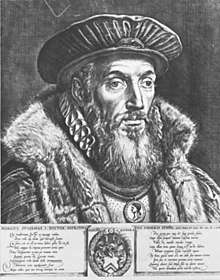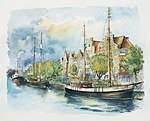Hanseatic League
The Hanseatic League (/ˌhænsiˈætɪk/; Middle Low German: Hanse, Düdesche Hanse, Hansa; German language: Deutsche Hanse; Dutch language: De Hanze; Latin: Hansa Teutonica)[2] was a commercial and defensive confederation of merchant guilds and market towns in Northwestern and Central Europe. Growing from a few North German towns in the late 1100s, the league came to dominate Baltic maritime trade for three centuries along the coasts of Northern Europe. Hansa territories stretched from the Baltic to the North Sea and inland during the Late Middle Ages, and diminished slowly after 1450.
Hanseatic League Hanse Hansa | |
|---|---|
 Northern Europe in the 1400s, showing the extent of the Hanseatic League | |
| Capital | Lübeck |
| Lingua franca | Middle Low German[1] |
| Membership | Various cities across the Baltic region |
Hanse is the Old High German word for a band or troop.[3] This word was applied to bands of merchants traveling between the Hanseatic cities — whether by land or by sea.[4] Hanse in Middle Low German came to mean a society of merchants or a trader guild.[5]
Merchant circles established the league to protect the guilds' economic interests and diplomatic privileges in their affiliated cities and countries, as well as along the trade routes which the merchants used. The Hanseatic cities had their own legal system and operated their own armies for mutual protection and aid. Despite this, the organization was not a state, nor could it be called a confederation of city-states; only a very small number of the cities within the league enjoyed autonomy and liberties comparable to those of a free imperial city.[6]
History

Exploratory trading adventures, raids, and piracy occurred early throughout the Baltic region; the sailors of Gotland sailed up rivers as far away as Novgorod.[7] Scandinavians led international trade in the Baltic area before the Hanseatic League, establishing major trading hubs at Birka, Haithabu, and Schleswig by the 9th century CE. The later Hanseatic ports between Mecklenburg and Königsberg, (present-day Kaliningrad) originally formed part of the Scandinavian-led Baltic trade-system.[8]
Historians generally trace the origins of the Hanseatic League to the rebuilding of the north German town of Lübeck in 1159 by the powerful Henry the Lion, Duke of Saxony and Bavaria, after he had captured the area from Adolf II, Count of Schauenburg and Holstein. More recent scholarship has deemphasized the focus on Lübeck due to it having been designed as one of several regional trading centers.[9]
German cities achieved domination of trade in the Baltic with striking speed during the 13th century, and Lübeck became a central node in the seaborne trade that linked the areas around the North and Baltic seas. The hegemony of Lübeck peaked during the 15th century.
Foundation and formation

Lübeck became a base for merchants from Saxony and Westphalia trading eastward and northward. Well before the term Hanse appeared in a document in 1267,[10] merchants in different cities began to form guilds, or Hansa, with the intention of trading with towns overseas, especially in the economically less-developed eastern Baltic. This area could supply timber, wax, amber, resins, and furs, along with rye and wheat brought down on barges from the hinterland to port markets. The towns raised their own armies, with each guild required to provide levies when needed. The Hanseatic cities came to the aid of one another, and commercial ships often had to be used to carry soldiers and their arms.
Visby (on the island of Gotland) functioned as the leading centre in the Baltic before the Hansa. Sailing east, Visby merchants established a trading post at Novgorod called Gutagard (also known as Gotenhof) in 1080.[11] Merchants from northern Germany also stayed there in the early period of the Gotlander settlement. Later they established their own trading station in Novgorod, known as Peterhof, which was further up-river, in the first half of the 13th century.[12] In 1229 German merchants at Novgorod were granted certain privileges that made their positions more secure.[13]
Hansa societies worked to remove restrictions on trade for their members. The earliest extant documentary mention, although without a name, of a specific German commercial federation dates from 1157 in London. That year, the merchants of the Hansa in Cologne convinced King Henry II of England to exempt them from all tolls in London[14] and allow them to trade at fairs throughout England. The "Queen of the Hansa", Lübeck, where traders were required to trans-ship goods between the North Sea and the Baltic, gained imperial privileges to become a free imperial city in 1226, as had Hamburg in 1189.
In 1241 Lübeck, which had access to the Baltic and North seas' fishing grounds, formed an alliance—a precursor to the League—with Hamburg, another trading city, which controlled access to salt-trade routes from Lüneburg. The allied cities gained control over most of the salt-fish trade, especially the Scania Market; Cologne joined them in the Diet of 1260. In 1266 King Henry III of England granted the Lübeck and Hamburg Hansa a charter for operations in England, and the Cologne Hansa joined them in 1282 to form the most powerful Hanseatic colony in London. Much of the drive for this co-operation came from the fragmented nature of existing territorial governments, which failed to provide security for trade. Over the next 50 years, the Hansa solidified with formal agreements for confederation and co-operation covering the west and east trade routes. The principal city and linchpin remained Lübeck; with the first general diet of the Hansa held there in 1356, the Hanseatic League acquired an official structure.
Commercial expansion
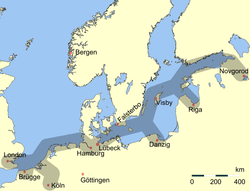
Lübeck's location on the Baltic provided access for trade with Scandinavia and Kievan Rus' (with its sea-trade center, Veliky Novgorod), putting it in direct competition with the Scandinavians who had previously controlled most of the Baltic trade-routes. A treaty with the Visby Hansa put an end to this competition: through this treaty the Lübeck merchants gained access to the inland Russian port of Novgorod, where they built a trading post or Kontor (literally: "office").[15] Although such alliances formed throughout the Holy Roman Empire, the league never became a closely managed formal organisation. Assemblies of the Hanseatic towns met irregularly in Lübeck for a Hansetag (Hanseatic day) from 1356 onwards, but many towns chose not to attend nor to send representatives, and decisions were not binding on individual cities. Over the period, a network of alliances grew to include a flexible roster of 70 to 170 cities.[16]
The league succeeded in establishing additional Kontors in Bruges (Flanders), Bergen (Norway), and London (England). These trading posts became significant enclaves. The London Kontor, established in 1320, stood west of London Bridge near Upper Thames Street, on the site now occupied by Cannon Street station. It grew into a significant walled community with its own warehouses, weighhouse, church, offices and houses, reflecting the importance and scale of trading activity on the premises. The first reference to it as the Steelyard (der Stahlhof) occurs in 1422.[17]
| Imports | Origin, Destination | Exports | Total | % | ||
|---|---|---|---|---|---|---|
| 150 | London/Hamburg | 38 | 188 | 34.4 | ||
| 44 | Livonian towns: | 51 | 95 | 17.4 | ||
| 10 | Riga | 14 | ||||
| 34 | Reval (Tallinn) | 14.3 | ||||
| - | Pernau | 22.7 | ||||
| 49.4 | Scania | 32.6 | 82 | 15 | ||
| 52 | Gotland, Sweden | 29.4 | 81.4 | 14.9 | ||
| 19 | Prussian towns: | 29.5 | 48.5 | 8.9 | ||
| 16 | Danzig | 22.8 | ||||
| 3 | Elbing | 6.6 | ||||
| 17.2 | Wendish & Pomeranian towns: | 25.2 | 42.4 | 7.8 | ||
| 5.5 | Stettin | 7 | ||||
| 4 | Stralsund | 7.5 | ||||
| 2.2 | Rostock | 4.6 | ||||
| 5.5 | Wismar | 6.1 | ||||
| 4.3 | Bergen | – | 4.3 | 0.8 | ||
| 3 | Small Baltic ports | 1.2 | 4.2 | 0.8 | ||
| 338.9 | Total | 206.9 | 545.8 | 100[18] |
Starting with trade in coarse woollen fabrics, the Hanseatic League had the effect of bringing both commerce and industry to northern Germany.[19] As trade increased, newer and finer woollen and linen fabrics, and even silks, were manufactured in northern Germany. The same refinement of products out of cottage industry occurred in other fields, e.g. etching, wood carving, armour production, engraving of metals, and wood-turning. The century-long monopolization of sea navigation and trade by the Hanseatic League ensured that the Renaissance arrived in northern Germany long before it did in the rest of Europe.[19]
In addition to the major Kontors, individual Hanseatic ports had a representative merchant and warehouse. In England this happened in Boston, Bristol, Bishop's Lynn (now King's Lynn, which features the sole remaining Hanseatic warehouse in England), Hull, Ipswich, Norwich, Yarmouth (now Great Yarmouth), and York.
The league primarily traded timber, furs, resin (or tar), flax, honey, wheat, and rye from the east to Flanders and England with cloth (and, increasingly, manufactured goods) going in the other direction. Metal ore (principally copper and iron) and herring came southwards from Sweden.
German colonists in the 12th and 13th centuries settled in numerous cities on and near the east Baltic coast, such as Elbing (Elbląg), Thorn (Toruń), Reval (Tallinn), Riga, and Dorpat (Tartu), which became members of the Hanseatic League, and some of which still retain many Hansa buildings and bear the style of their Hanseatic days. Most were granted Lübeck law (Lübisches Recht), after the league's most prominent town. The law provided that they had to appeal in all legal matters to Lübeck's city council. The Livonian Confederation of 1435 to c. 1582 incorporated modern-day Estonia and parts of Latvia and had its own Hanseatic parliament (diet); all of its major towns became members of the Hanseatic League. The dominant language of trade was Middle Low German, a dialect with significant impact for countries involved in the trade, particularly the larger Scandinavian languages, Estonian, and Latvian.
Zenith
The league had a fluid structure, but its members shared some characteristics; most of the Hansa cities either started as independent cities or gained independence through the collective bargaining power of the league, though such independence remained limited. The Hanseatic free cities owed allegiance directly to the Holy Roman Emperor, without any intermediate family tie of obligation to the local nobility.

.jpg)
Another similarity involved the cities' strategic locations along trade routes. At the height of their power in the late-14th century, the merchants of the Hanseatic League succeeded in using their economic power and, sometimes, their military might—trade routes required protection and the league's ships sailed well-armed—to influence imperial policy.
The league also wielded power abroad. Between 1361 and 1370 it waged war against Denmark. Initially unsuccessful, Hanseatic towns in 1368 allied in the Confederation of Cologne, sacked Copenhagen and Helsingborg, and forced Valdemar IV, King of Denmark, and his son-in-law Haakon VI, King of Norway, to grant the league 15% of the profits from Danish trade in the subsequent peace treaty of Stralsund in 1370, thus gaining an effective trade and economic monopoly in Scandinavia. This favourable treaty marked the height of Hanseatic power. After the Danish-Hanseatic War (1426–1435) and the Bombardment of Copenhagen (1428), the Treaty of Vordingborg renewed the commercial privileges in 1435.[20][21][22]
The Hansa also waged a vigorous campaign against pirates. Between 1392 and 1440 maritime trade of the league faced danger from raids of the Victual Brothers and their descendants, privateers hired in 1392 by Albert of Mecklenburg, King of Sweden, against Margaret I, Queen of Denmark. In the Dutch–Hanseatic War (1438–1441), the merchants of Amsterdam sought and eventually won free access to the Baltic and broke the Hanseatic monopoly. As an essential part of protecting their investment in ships and their cargoes, the League trained pilots and erected lighthouses.
Most foreign cities confined the Hanseatic traders to certain trading areas and to their own trading posts. They seldom interacted with the local inhabitants, except when doing business. Many locals, merchant and noble alike, envied the power of the League and tried to diminish it. For example, in London, the local merchants exerted continuing pressure for the revocation of privileges. The refusal of the Hansa to offer reciprocal arrangements to their English counterparts exacerbated the tension. King Edward IV of England reconfirmed the league's privileges in the Treaty of Utrecht (1474) despite the latent hostility, in part thanks to the significant financial contribution the League made to the Yorkist side during the Wars of the Roses of 1455–1487. In 1597 Queen Elizabeth of England expelled the League from London, and the Steelyard closed the following year. Tsar Ivan III of Russia closed the Hanseatic Kontor at Novgorod in 1494. The very existence of the League and its privileges and monopolies created economic and social tensions that often crept over into rivalries between League members.[23]
Rise of rival powers
The economic crises of the late 15th century did not spare the Hansa. Nevertheless, its eventual rivals emerged in the form of the territorial states, whether new or revived, and not just in the west: Ivan III, Grand Prince of Moscow, ended the entrepreneurial independence of Hansa's Novgorod Kontor in 1478—it closed completely and finally in 1494.[24] New vehicles of credit were imported from Italy, where double-entry book-keeping was invented in 1492, and outpaced the Hansa economy, in which silver coins changed hands rather than bills of exchange.
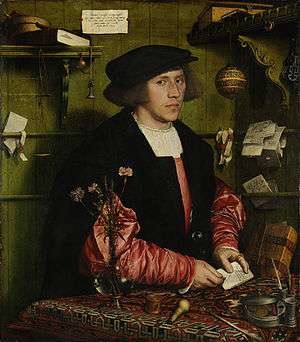
In the 15th century, tensions between the Prussian region and the "Wendish" cities (Lübeck and its eastern neighbours) increased. Lübeck was dependent on its role as centre of the Hansa, being on the shore of the sea without a major river. It was on the entrance of the land route to Hamburg, but this land route could be bypassed by sea travel around Denmark and through the Kattegat. Prussia's main interest, on the other hand, was the export of bulk products like grain and timber, which were very important for England, the Low Countries, and, later on, also for Spain and Italy.
In 1454, the year of the marriage of Elisabeth of Austria to the Jagiellonian king, the towns of the Prussian Confederation rose up against the dominance of the Teutonic Order and asked Casimir IV, King of Poland, for help. Gdańsk (Danzig), Thorn and Elbing became part of the Kingdom of Poland, (from 1466 to 1569 referred to as Royal Prussia, region of Poland) by the Second Peace of Thorn (1466). Poland in turn was heavily supported by the Holy Roman Empire through family connections and by military assistance under the Habsburgs. Kraków, then the capital of Poland, had a loose association with the Hansa.[25] The lack of customs borders on the River Vistula after 1466 helped to gradually increase Polish grain exports, transported to the sea down the Vistula, from 10,000 short tons (9,100 t) per year, in the late 15th century, to over 200,000 short tons (180,000 t) in the 17th century.[26] The Hansa-dominated maritime grain trade made Poland one of the main areas of its activity, helping Danzig to become the Hansa's largest city.
The member cities took responsibility for their own protection. In 1567, a Hanseatic League agreement reconfirmed previous obligations and rights of league members, such as common protection and defense against enemies.[27] The Prussian Quartier cities of Thorn, Elbing, Königsberg and Riga and Dorpat also signed. When pressed by the King of Poland–Lithuania, Danzig remained neutral and would not allow ships running for Poland into its territory. They had to anchor somewhere else, such as at Pautzke (Puck).

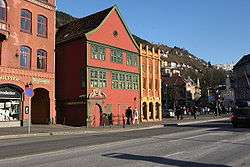
A major economic advantage for the Hansa was its control of the shipbuilding market, mainly in Lübeck and in Danzig. The Hansa sold ships everywhere in Europe, including Italy. They drove out the Dutch, because Holland wanted to favour Bruges as a huge staple market at the end of a trade route. When the Dutch started to become competitors of the Hansa in shipbuilding, the Hansa tried to stop the flow of shipbuilding technology from Hanseatic towns to Holland. Danzig, a trading partner of Amsterdam, attempted to forestall the decision. Dutch ships sailed to Danzig to take grain from the city directly, to the dismay of Lübeck. Hollanders also circumvented the Hanseatic towns by trading directly with north German princes in non-Hanseatic towns. Dutch freight costs were much lower than those of the Hansa, and the Hansa were excluded as middlemen.
When Bruges, Antwerp and Holland all became part of the Duchy of Burgundy they actively tried to take over the monopoly of trade from the Hansa, and the staples market from Bruges was transferred to Amsterdam. The Dutch merchants aggressively challenged the Hansa and met with much success. Hanseatic cities in Prussia, Livonia, supported the Dutch against the core cities of the Hansa in northern Germany. After several naval wars between Burgundy and the Hanseatic fleets, Amsterdam gained the position of leading port for Polish and Baltic grain from the late 15th century onwards. The Dutch regarded Amsterdam's grain trade as the mother of all trades (Moedernegotie).
Nuremberg in Franconia developed an overland route to sell formerly Hansa-monopolised products from Frankfurt via Nuremberg and Leipzig to Poland and Russia, trading Flemish cloth and French wine in exchange for grain and furs from the east. The Hansa profited from the Nuremberg trade by allowing Nurembergers to settle in Hanseatic towns, which the Franconians exploited by taking over trade with Sweden as well. The Nuremberger merchant Albrecht Moldenhauer was influential in developing the trade with Sweden and Norway, and his sons Wolf Moldenhauer and Burghard Moldenhauer established themselves in Bergen and Stockholm, becoming leaders of the local Hanseatic activities.
End of the Hansa
At the start of the 16th century, the league found itself in a weaker position than it had known for many years. The rising Swedish Empire had taken control of much of the Baltic Sea. Denmark had regained control over its own trade, the Kontor in Novgorod had closed, and the Kontor in Bruges had become effectively moribund. The individual cities making up the league had also started to put self-interest before their common Hanseatic interests. Finally, the political authority of the German princes had started to grow, constraining the independence of the merchants and Hanseatic towns.
The league attempted to deal with some of these issues: it created the post of Syndic in 1556 and elected Heinrich Sudermann as a permanent official with legal training, who worked to protect and extend the diplomatic agreements of the member towns. In 1557 and 1579 revised agreements spelled out the duties of towns and some progress was made. The Bruges Kontor moved to Antwerp and the Hansa attempted to pioneer new routes. However the league proved unable to prevent the growing mercantile competition, and so a long decline commenced. The Antwerp Kontor closed in 1593, followed by the London Kontor in 1598. The Bergen Kontor continued until 1754; of all the Kontore, only its buildings, the Bryggen, survive.
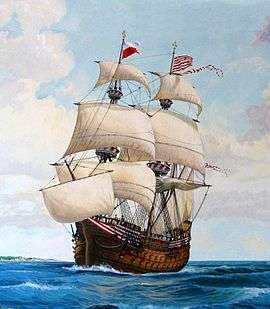
The gigantic warship Adler von Lübeck was constructed for military use against Sweden during the Northern Seven Years' War (1563–70) but was never put to military use, epitomizing the vain attempts of Lübeck to uphold its long-privileged commercial position in a changing economic and political climate.
By the late 17th century, the league had imploded and could no longer deal with its own internal struggles. The social and political changes that accompanied the Protestant Reformation included the rise of Dutch and English merchants and the pressure of the Ottoman Empire upon the Holy Roman Empire and its trade routes. Only nine members attended the last formal meeting in 1669 and only three (Lübeck, Hamburg and Bremen) remained as members until its demise in 1862, in the wake of the creation of the German Empire under Kaiser Wilhelm I.[28][29] Hence, only Lübeck, Hamburg, and Bremen retain the words "Hanseatic City" in their official German titles.
Organization
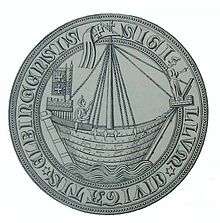
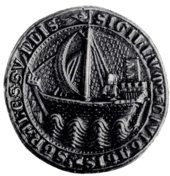
The members of the Hanseatic League were Low German merchants, whose towns were, with the exception of Dinant, where these merchants held citizenship. Not all towns with Low German merchant communities were members of the league (e.g., Emden, Memel (today Klaipėda), Viborg (today Vyborg) and Narva never joined). However, Hanseatic merchants could also come from settlements without German town law—the premise for league membership was birth to German parents, subjection to German law, and a commercial education. The league served to advance and defend the common interests of its heterogeneous members: commercial ambitions such as enhancement of trade, and political ambitions such as ensuring maximum independence from the noble territorial rulers.[30]:10–11The Hanseatic League was by no means a monolithic organization or a 'state within a state' but rather a complex and loose-jointed confederation of protagonists pursuing their own interests, which coincided in a shared program of economic domination in the Baltic region. [31]:37–38
Decisions and actions of the Hanseatic League were the consequence of a consensus-based procedure. If an issue arose, the league's members were invited to participate in a central meeting, the Tagfahrt ("meeting ride", sometimes also referred to as Hansetag, since 1358). The member communities then chose envoys (Ratssendeboten) to represent their local consensus on the issue at the Tagfahrt. Not every community sent an envoy; delegates were often entitled to represent a set of communities. Consensus-building on local and Tagfahrt levels followed the Low Saxon tradition of Einung, where consensus was defined as absence of protest: after a discussion, the proposals which gained sufficient support were dictated aloud to the scribe and passed as binding Rezess if the attendees did not object; those favouring alternative proposals unlikely to get sufficient support were obliged to remain silent during this procedure. If consensus could not be established on a certain issue, it was found instead in the appointment of a number of league members who were then empowered to work out a compromise.[30]:70–72
The Hanseatic Kontore, which operated like an early stock exchange,[32] each had their own treasury, court and seal. Like the guilds, the Kontore were led by Ältermänner ("eldermen", or English aldermen). The Stalhof Kontor, as a special case, had a Hanseatic and an English Ältermann. In 1347 the Kontor of Brussels modified its statute to ensure an equal representation of the league's members. To that end, member communities from different regions were pooled into three circles (Drittel ("third [part]"): the Wendish and Saxon Drittel, the Westphalian and Prussian Drittel as well as the Gothlandian, Livonian and Swedish Drittel. The merchants from their respective Drittel would then each choose two Ältermänner and six members of the Eighteen Men's Council (Achtzehnmännerrat) to administer the Kontor for a set period of time. In 1356, during a Hanseatic meeting in preparation of the first Tagfahrt, the league confirmed this statute. The league in general gradually adopted and institutionalized the division into Drittel (see table).[30]:62–63[33][34][35]
| Drittel (1356–1554) | Regions | Chief city (Vorort) |
|---|---|---|
| Wendish-Saxon | Holstein, Saxony, Mecklenburg, Pomerania, Brandenburg | Lübeck |
| Westphalian-Prussian | Westphalia, Rhineland, Prussia | Dortmund, later Cologne |
| Gothlandian-Livonian-Swedish | Gotland, Livonia, Sweden | Visby, later Riga |
The Tagfahrt or Hansetag was the only central institution of the Hanseatic League. However, with the division into Drittel, the members of the respective subdivisions frequently held a Dritteltage ("Drittel meeting") to work out common positions which could then be presented at a Tagfahrt. On a more local level, league members also met, and while such regional meetings were never formalized into a Hanseatic institution, they gradually gained importance in the process of preparing and implementing Tagfahrt decisions.[36]
Quarters
From 1554, the division into Drittel was modified to reduce the circles' heterogeneity, to enhance the collaboration of the members on a local level and thus to make the league's decision-making process more efficient.[37] The number of circles rose to four, so they were called Quartiere (quarters):[33]
| Quartier (since 1554) | Chief city (Vorort) |
|---|---|
| Wendish and Pomeranian[38] | Lübeck[38] |
| Saxon, Thuringian and Brandenburg[38] | Brunswick,[38] Magdeburg |
| Prussia, Livonia and Sweden[38] – or East Baltic[39]:120 | Danzig (now Gdańsk)[38] |
| Rhine, Westphalia and the Netherlands[38] | Cologne[38] |
This division was however not adopted by the Kontore, who, for their purposes (like Ältermänner elections), grouped the league members in different ways (e.g., the division adopted by the Stahlhof in London in 1554 grouped the league members into Dritteln, whereby Lübeck merchants represented the Wendish, Pomeranian Saxon and several Westphalian towns, Cologne merchants represented the Cleves, Mark, Berg and Dutch towns, while Danzig merchants represented the Prussian and Livonian towns).[40]
Lists of former Hansa cities
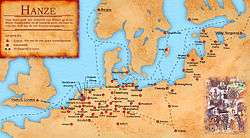
The names of the Quarters have been abbreviated in the following table:
- Wendish: Wendish and Pomeranian[38] (or just Wendish)[39]:120 Quarter
- Saxon: Saxon, Thuringian and Brandenburg[38] (or just Saxon)[39]:120 Quarter
- Baltic: Prussian, Livonian and Swedish[38] (or East Baltic)[39]:120 Quarter
- Westphalian: Rhine-Westphalian and Netherlands (including Flanders)[38] (or Rhineland)[39]:120 Quarter
Kontor: The Kontore were foreign trading posts of the League, not cities that were Hanseatic members, and are set apart in a separate table below.
The remaining column headings are as follows:
- "City" is the name, with any variants.
- "Territory" indicates the jurisdiction to which the city was subject at the time of the League.
- "Now" indicates the modern nation-state in which the city is located.
- "From" and "Until" record the dates at which the city joined and/or left the league.
Hansa Proper
| Quarter | City | Territory | Now | From | Until | Notes | Refs |
|---|---|---|---|---|---|---|---|
| Wendish | Capital of the Hanseatic League, capital of the Wendish and Pomeranian Circle | ||||||
| Wendish | |||||||
| Wendish | |||||||
| Wendish | Joined the 10-year Rostock Peace Treaty (Rostocker Landfrieden) in 1283, which was the predecessor of the federation of Wendish towns (1293 onwards). | ||||||
| Wendish | Joined the 10-year Rostock Peace Treaty in 1283, which was the predecessor of the federation of Wendish towns (1293 onwards). | ||||||
| Wendish | 1293 | Rügen was a fief of the Danish crown to 1325. Stralsund joined the 10-year Rostock Peace Treaty in 1283, which was the predecessor of the federation of Wendish towns (1293 onwards). From 1339 to the 17th century, Stralsund was a member of the Vierstädtebund with Greifswald, Demmin and Anklam. | |||||
| Wendish | Joined the 10-year Rostock Peace Treaty in 1283, which was the predecessor of the federation of Wendish towns (1293 onwards). From 1339 to the 17th century, Demmin was a member of the Vierstädtebund with Stralsund, Greifswald and Anklam. | ||||||
| Wendish | Joined the 10-year Rostock Peace Treaty in 1283, which was the predecessor of the federation of Wendish towns (1293 onwards). From 1339 to the 17th century, Greifswald was a member of the Vierstädtebund with Stralsund, Demmin and Anklam. | ||||||
| Wendish | Joined the 10-year Rostock Peace Treaty in 1283, which was the predecessor of the federation of Wendish towns (1293 onwards). From 1339 to the 17th century, Anklam was a member of the Vierstädtebund with Stralsund, Greifswald and Demmin. | ||||||
| Wendish | 1278 | Joined the 10-year Rostock Peace Treaty in 1283, which was the predecessor of the federation of Wendish towns (1293 onwards); since the 14th century gradually adopted the role of a chief city for the Pomeranian Hanseatic towns to its east | |||||
| Wendish | |||||||
| Wendish | |||||||
| Wendish | |||||||
| Wendish | |||||||
| Baltic | 1470 | In 1285 at Kalmar, the League agreed with Magnus III, King of Sweden, that Gotland be joined with Sweden. In 1470, Visby's status was rescinded by the League, with Lübeck razing the city's churches in May 1525. | |||||
| Baltic | |||||||
| Saxon | 13th century | 17th century | Capital of the Saxon, Thuringian and Brandenburg Circle | ||||
| Saxon | 1260 | ||||||
| Saxon | 13th century | Capital of the Saxon, Thuringian and Brandenburg Circle | |||||
| Saxon | 1267 | 1566 | Goslar was a fief of Saxony until 1280. | ||||
| Saxon | 1430 | ||||||
| Saxon | |||||||
| Saxon | 1442 | Brandenburg was raised to an Electorate in 1356. Elector Frederick II caused all the Brandenburg cities to leave the League in 1442. | |||||
| Saxon | 1430 | 1442 | Elector Frederick II caused all the Brandenburg cities to leave the League in 1442. | ||||
| Baltic | 1358 | Capital of the Prussian, Livonian and Swedish (or East Baltic) Circle. Danzig had been first a part of the Duchy of Pomerelia, a fief of the Polish Crown, with Polish-Kashubian population, then part of the State of the Teutonic Order from 1308 until 1457. After the Second Peace of Thorn (1466), Royal Prussia including Gdańsk was part of the Kingdom of Poland. | |||||
| Baltic | 1358 | Elbing had originally been part of the territory of the Old Prussians, until the 1230s when it became part of the State of the Teutonic Order. After the Second Peace of Thorn (1466), Royal Prussia, including Elbląg was part of the Kingdom of Poland. | |||||
| Baltic | 1280 | Toruń was part of the State of the Teutonic Order from 1233 until 1466. After the Second Peace of Thorn (1466), Royal Prussia, including Toruń, was part of the Kingdom of Poland. | |||||
| Baltic | c. 1370 | c. 1500 | Kraków was the capital of the Kingdom of Poland, 1038–1596/1611. It adopted Magdeburg town law and 5000 Poles and 3500 Germans lived within the city proper in the 15th century; Poles steadily rose in the ranks of guild memberships reaching 41% of guild members in 1500. It was very loosely associated with Hansa, and paid no membership fees, nor sent representatives to League meetings. | ||||
| Baltic | 1387 | 1474 | Breslau, a part of the Duchy of Breslau and the Kingdom of Bohemia, was only loosely connected to the League and paid no membership fees nor did its representatives take part in Hansa meetings | ||||
| Baltic | 1340 | Königsberg was the capital of the Teutonic Order, becoming the capital of Ducal Prussia on the Order's secularisation in 1466. Ducal Prussia was a German principality that was a fief of the Polish crown until gaining its independence in the 1660 Treaty of Oliva. The city was renamed Kaliningrad in 1946 after East Prussia was divided between the People's Republic of Poland and the Soviet Union at the Potsdam Conference. | |||||
| Baltic | 1282 | During the Livonian War (1558–83), Riga became a Free imperial city until the 1581 Treaty of Drohiczyn ceded Livonia to the Polish–Lithuanian Commonwealth until the city was captured by Sweden in the Polish–Swedish War (1621–1625). | |||||
| Baltic | 1285 | On joining the Hanseatic League, Reval was a Danish fief, but was sold, with the rest of northern Estonia, to the Teutonic Order in 1346. After the Livonian War (1558–83), northern Estonia became a part of the Swedish Empire. | |||||
| Baltic | 1280s | The Bishopric of Dorpat gained increasing autonomy within the Terra Mariana. During the Livonian War (1558–83), Dorpat fell under the rule of the Grand Duchy of Lithuania, with the 1581 Treaty of Drohiczyn definitively ceding Livonia to the Polish–Lithuanian Commonwealth until the city was captured by Sweden in the Polish–Swedish War (1621–1625). | |||||
| Westphalian | 1669 | Capital of the Rhine-Westphalian and Netherlands Circle until after the Anglo-Hanseatic War (1470–74), when the city was prosecuted in 1475 with temporary trade sanctions (German: Verhanst) for some years for having supported England; Dortmund was made capital of the Circle. Cologne also was called "Electorate of Cologne" (German: Kurfürstentum Köln or Kurköln). In June 1669 the last Hanseday was held in the town of Lübeck by the last remaining Hanse members, amongst others Cologne. | |||||
| Westphalian | After Cologne was excluded after the Anglo-Hanseatic War (1470–74), Dortmund was made capital of the Rhine-Westphalian and Netherlands Circle. | ||||||
| Westphalian | 1000 | 1500 | |||||
| Westphalian | 1441 | ||||||
| Westphalian | |||||||
| Westphalian | |||||||
| Westphalian | 12th century | ||||||
| Westphalian | 1609 | The city was a part of the Electorate of Cologne until acquiring its freedom in 1444–49, after which it aligned with the Duchy of Cleves. |
Kontore
| Quarter | City | Territory | Now | From | Until | Notes | Refs |
|---|---|---|---|---|---|---|---|
| Kontor | 1500s | Novgorod was one of the principal Kontore of the League and the easternmost. In 1499, Ivan III, Grand Prince of Moscow, closed the Peterhof; it was reopened a few years later, but the League's Russian trade never recovered. | |||||
| Kontor | 1360 | 1775 | Bryggen was one of the principal Kontore of the League. It was razed by accidental fire in 1476. In 1560, administration of Bryggen was placed under Norwegian administration. | ||||
| Kontor | Bruges was one of the principal Kontore of the League until the 15th century, when the seaway to the city silted up; trade from Antwerp benefiting from Bruges's loss. | ||||||
| Kontor | 1303 | 1853 | The Steelyard was one of the principal Kontore of the League. King Edward I granted a Carta Mercatoria in 1303. The Steelyard was destroyed in 1469 and Edward IV exempted Cologne merchants, leading to the Anglo-Hanseatic War (1470–74). The Treaty of Utrecht, sealing the peace, led to the League purchasing the Steelyard outright in 1475, with Edward having renewed the League's privileges without insisting on reciprocal rights for English merchants in the Baltic. London merchants persuaded Elizabeth I to rescind the League's privileges on 13 January 1598; while the Steelyard was re-established by James I, the advantage never returned. Consulates continued however, providing communication during the Napoleonic Wars, and the Hanseatic interest was only sold in 1853. | ||||
| Kontor | Antwerp became a major Kontor of the League, particularly after the seaway to Bruges silted up in the 15th century, leading to its fortunes waning in Antwerp's favour, despite Antwerp's refusal to grant special privileges to the League's merchants. Between 1312 and 1406, Antwerp was a margraviate, independent of Brabant. | ||||||
| Kontor | Bishop's Lynn (King's Lynn) | 1751 | The Hanseatic Warehouse was constructed in 1475 as part of the Treaty of Utrecht, allowing the League to establish a trading depot in Lynn for the first time. It is the only surviving League building in England. | ||||
| Kontor | Ipswich was a headport with jurisdiction over Colchester, Maldon and Harwich. In the 14th century, traders from Ipswich experienced problems when engaged in Hansa ports in the Baltic, with occasions when they were subject to mass arrests and seizure of goods. However during the 15th century more positive relations developed with Hansa merchants from Cologne. However by 1451 Ipswich bailiffs seized hanseatic ships and in 1456 hanseatic merchants complained of their ships being attacked and prevented from leaving the port. During the Anglo-Hanseatic War, Cologne merchants opposed the war and were suspended from the league. However when the war was brought to an end by the Treaty of Utrecht in 1474, the trade with Cologne declined and by the end of the century the hanseatic trade in Ipswich was very limited.[65] | ||||||
| Kontor | 15th century | Skåne (Scania) was Danish until ceded to Sweden by the 1658 Treaty of Roskilde, during the Second Northern War. | |||||
| Kontor | 15th century | Skåne was Danish until ceded to Sweden by the 1658 Treaty of Roskilde, during the Second Northern War. | |||||
| Kontor | 1441 | In 1398 traders guild with close ties to Hanseatic league appeared in Kaunas. Treaty with Hanseatic league was signed in 1441. The main office was located in the House of Perkūnas from 1441 till 1532. | |||||
| Kontor | In the 12th and 13th centuries, Pskov adhered to the Novgorod Republic. It was captured by the Teutonic Order in 1241 and liberated by a Lithuanian prince, becoming a de facto sovereign republic by the 14th century. | ||||||
| Kontor | Polotsk was an autonomous principality of Kievan Rus' until gaining its independence in 1021. From 1240, it became a vassal of the Grand Duchy of Lithuania, being fully integrated into the Grand Duchy in 1307. |
Ports with Hansa trading posts
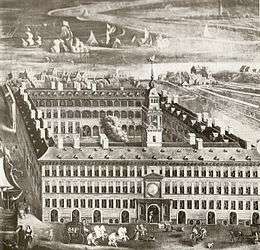
Other cities with a Hansa community
- Aberdeen[67]
- Åbo (Turku)[59]
- Arnhem[61]:432[68]
- Avaldsnes[47][63]
- Bolsward[44][69]
- Bordeaux[59]
- Brae[59]
- Doesburg[60][61]:433
- Elburg[60][61]:433
- Fellin (Viljandi)[34][45]
- Goldingen (Kuldīga)[34]
- Göttingen[35][44][45][70]
- Grindavík[59]
- Grundarfjörður[59]
- Gunnister[59][63][71]
- Haapsalu[34]
- Hafnarfjörður[47][59][72]
- Hamelin[45]
- Hanover[35][44][45]
- Harderwijk
- Harlingen
- Haroldswick[59]
- Hasselt[35][43][60]
- Hattem[43][60]
- Herford[42]:82[43][44][45][64]:391
- Hildesheim[35][44][45]
- Hindeloopen (Hylpen)[61]:397[73]
- Kalmar[43][74]
- Kokenhusen (Koknese)[34][43][45][75][76][77]
- Krambatangi[47][63]
- Kumbaravogur[78]
- Kulm (Chełmno)[35][43][45]
- Leghorn[79]:98
- Lemgo[35][43][44][45]
- Lemsal (Limbaži)[34][43][45]
- Lippe[35][44]
- Lisbon[80]
- Lunna Wick[59]
- Messina[81]
- Minden[35][43][44][45]
- Naples[81]
- Nantes[59]
- Narva[34][59]
- Nijmegen[43][44][47]
- Nordhausen[35][43]
- Nyborg[59]
- Nyköping[43]
- Oldenzaal[43]
- Ommen
- Paderborn[35][43][45]
- Pernau (Pärnu)[34][35][43][45]
- Roermond
- Roop (Straupe)[34]
- Scalloway
- Smolensk
- Stargard[35][41][43][45][52]:476
- Stavoren (Starum)[61]:398
- Tórshavn[47][59]
- Trondheim[63]
- Tver
- Uelzen
- Venlo
- Vilnius[34][59]
- Walk (Valka)[34]
- Weißenstein (Paide)[34]
- Wenden (Cēsis)[34][43][45][58]:60
- Wesel[43][44]
- Wesenberg (Rakvere)[34]
- Windau (Ventspils)[34][43]
- Wolmar (Valmiera)[34][43][45]
- Zutphen[35][43][44][60][61]:433
- Zwolle[35][43][44][60][61]:433, 439
Legacy Hanseatic connections
Despite its collapse, several cities still maintained the link to the Hanseatic League. Dutch cities including Groningen, Deventer, Kampen, Zutphen and Zwolle, and a number of German cities including Bremen, Demmin, Greifswald, Hamburg, Lübeck, Lüneburg, Rostock, Stade, Stralsund and Wismar still call themselves Hanse cities (their car license plates are prefixed H, e.g. –HB– for "Hansestadt Bremen"). Hamburg and Bremen continue to style themselves officially as "free Hanseatic cities", with Lübeck named "Hanseatic City" (Rostock's football team is named F.C. Hansa Rostock in memory of the city's trading past). For Lübeck in particular, this anachronistic tie to a glorious past remained especially important in the 20th century. In 1937, the Nazi Party removed this privilege through the Greater Hamburg Act possibly because the Senat of Lübeck did not permit Adolf Hitler to speak in Lübeck during his 1932 election campaign.[82] He held the speech in Bad Schwartau, a small village on the outskirts of Lübeck. Subsequently, he referred to Lübeck as "the small city close to Bad Schwartau."
After the EU enlargement to the East in May 2004 there were some experts who wrote about the resurrection of the Baltic Hansa.[83]
The legacy of the Hansa is remembered today in several names: the German airline Lufthansa (i.e., "Air Hansa"); F.C. Hansa Rostock; Hanze University of Applied Sciences, Groningen, Netherlands; Hanze oil production platform, Netherlands; the Hansa Brewery in Bergen and the Hanse Sail in Rostock. DDG Hansa was a major German shipping company from 1881 until its bankruptcy in 1980. Hansabank in the Baltic states, which has been rebranded into Swedbank. Hansa-Park, one of the biggest theme parks in Germany.
There are two museums in Europe dedicated specifically to the history of the Hanseatic League: the European Hansemuseum in Lübeck and the Hanseatic Museum and Schøtstuene in Bergen.
Modern versions of the Hanseatic League
"City League The Hanse"

In 1980, former Hanseatic League members established a "new Hanse" in Zwolle. This league is open to all former Hanseatic League members and cities that share a Hanseatic Heritage. In 2012 the New Hanseatic league had 187 members. This includes twelve Russian cities, most notably Novgorod, which was a major Russian trade partner of the Hansa in the Middle Ages. The "new Hanse" fosters and develops business links, tourism and cultural exchange.[84]
The headquarters of the New Hansa is in Lübeck, Germany. The current President of the Hanseatic League of New Time is Bernd Saxe, Mayor of Lübeck.[84]
Each year one of the member cities of the New Hansa hosts the Hanseatic Days of New Time international festival.
In 2006 King's Lynn became the first English member of the newly formed new Hanseatic League.[85] It was joined by Hull in 2012 and Boston in 2016.[86]
New Hanseatic League
The New Hanseatic League was established in February 2018 by finance ministers from Denmark, Estonia, Finland, Ireland, Latvia, Lithuania, the Netherlands and Sweden through the signing of a two-page foundational document which set out the countries' "shared views and values in the discussion on the architecture of the EMU."
Historical maps
 Europe in 1097
Europe in 1097- Europe in 1430
 Europe in 1470
Europe in 1470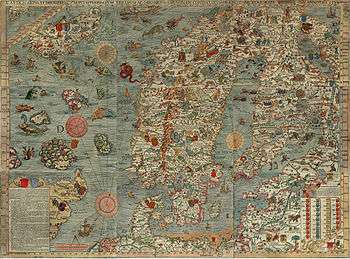 Carta marina of the Baltic Sea region (1539)
Carta marina of the Baltic Sea region (1539)
See also
- Baltic maritime trade (c. 1400–1800)
- Bay Fleet
- Brick Gothic
- Company of Merchant Adventurers of London
- Hanseatic Cross
- Hanseatic Days of New Time
- Hanseatic flags
- Hanseatic Museum and Schøtstuene
- Hanseatic Trade Center
- Lufthansa
- Maritime republics
- Schiffskinder
- Thalassocracy
- The Patrician
- Hansa Records
References
- Cordes, Gerhard; Möhn, Dieter (1983). Handbuch zur niederdeutschen Sprach- und Literaturwissenschaft. Erich Schmidt Verlag. p. 119. ISBN 3-503-01645-7.
- "Synonym-Details zu 'Deutsche Hanse · Düdesche Hanse · Hansa Teutonica (lat.)". openthesaurus. Retrieved 9 June 2018.
- Seebold, Elmar (2008). Chronologisches Wörterbuch des deutschen Wortschatzes, Vol. 2 Der Wortschatz des 9. Jahrhunderts. Walter de Gruyter. p. 388. ISBN 978-3-11-020502-2.
- "Hanse". Planet Wissen. 11 March 2018. Retrieved 9 June 2018.
- "Mittelniederdeutsches Wörterbuch". Gerhard Köbler. 3 August 2014. Retrieved 9 August 2020.
- Hansen, Mogens Herman (2000). A comparative study of thirty city-state cultures: an investigation. Royal Danish Academy of Sciences & Letters: Copenhagen Polis Centre (Historisk-filosofiske Skrifter 21). p. 305.
- Janet Martin, "Les Uškujniki de Novgorod: Marchands ou Pirates?" Cahiers du Monde Russe et Sovietique 16 (1975): 5–18.
- Smith, Jillian R. (May 2010). "2". Hanseatic Cogs and Baltic Trade: Interrelations Between Trade, Technology and Ecology (Thesis). University of Nebraska at Lincoln. Retrieved 1 July 2019.
- Ewert, Ulf Christian; Sunder, Marco (2 September 2011). Trading Networks, Monopoly and Economic Development in Medieval Northern Europe: an Agent-Based Simulation of Early Hanseatic Trade. 9th European Historical Economics Society Conference. Dublin, Ireland.
- Compare: Sartorius Von Waltershausen, Georg-Friedrich-Christoph (1830). Lappenberg, J. M. (ed.). Urkundliche Geschichte des Ursprunges der deutschen Hanse [History of the origin of the German Hanse in documents] (in German). 2. Hamburg: Friedrich Perthes. p. 94.
- "The Cronicle of the Hanseatic League". Archived from the original on 7 March 2012. Retrieved 10 December 2011.
- Justyna Wubs-Mrozewicz, Traders, ties and tensions: the interactions of Lübeckers, Overijsslers and Hollanders in Late Medieval Bergen, Uitgeverij Verloren, 2008 p. 111
- Translation of the grant of privileges to merchants in 1229: "Medieval Sourcebook: Privileges Granted to German Merchants at Novgorod, 1229". Fordham.edu. Retrieved 20 July 2009.
-
Compare:
Lloyd, T. H. (1991). "The winning of the Hanse franchises, 1157–1361". England and the German Hanse, 1157–1611: A Study of Their Trade and Commercial Diplomacy (revised ed.). Cambridge: Cambridge University Press (published 2002). p. 15. ISBN 9780521522144. Retrieved 2 February 2020.
[A] grant of about 1157 [...] conferred perpetual protection upon the homines et cives Colonienses. As long as they paid estblished dues they were to be treated as the king's own men and no fresh charges would be levied on them without their consent. By this time they had some form of corporate organisation with a headquarters in London [...].
- "Ancient Rus: trade and crafts :: History of Russian trade and crafts :: Business & Law :: Russia-InfoCentre". russia-ic.com. Retrieved 20 March 2019.
- Braudel, Fernand (17 January 2002). The Perspective of the World. Volume 3: Civilization and Capitalism, 15th–18th century. Phoenix Press. ISBN 1-84212-289-4.
- Compare "steelyard". Oxford English Dictionary (3rd ed.). Oxford University Press. September 2005. (Subscription or UK public library membership required.) A Latin quotation has: In civitate Londonia..in Curia Calibis from 1394.
- Hanseatic League, p.198, App.IV p.431
- Frederick Engels "The Peasant War in Germany" contained in the Collected Works of Karl Marx and Frederick Engels: Volume 10 (International Publishers: New York, 1978) p. 400.
- Pulsiano, Phillip; Kirsten Wolf (1993). Medieval Scandinavia: An Encyclopedia. Taylor & Francis. p. 265. ISBN 0-8240-4787-7.
- Stearns, Peter N; William Leonard Langer (2001). The Encyclopedia of World History: Ancient, Medieval, and Modern, Chronologically Arranged. Houghton Mifflin Harcourt. p. 265. ISBN 0-395-65237-5.
- MacKay, Angus; David Ditchburn (1997). Atlas of Medieval Europe. Routledge. p. 171. ISBN 0-415-01923-0.
- Dollinger, Philippe (2000). The German Hansa. Routledge. pp. 341–43. ISBN 978-0-415-19073-2. Retrieved 30 April 2011.
- Meier, Dirk (2009). Seafarers, Merchants and Pirates in the Middle ages. Boyden Press. ISBN 978-1-84383-5-127., 145.
- Blumówna, Helena. Kraków jego dzieje i sztuka: Praca zbiorowa [Krakow's history and art: Collective work]. Katowice: 1966. p. 93.
- Davies, Norman (1982). God's playground. A history of Poland, Volume 1: The Origins to 1795. Oxford University Press. ISBN 978-0-19-925339-5.
- "Agreement of the Hanseatic League at Lübeck, 1557". Baltic Connections. Archived from the original on 4 January 2009. Retrieved 5 May 2009.
- "Die Hanse". Exulanten. Retrieved 17 April 2020.
- "Bremen, Hamburg and Luebeck: Culinary Treasures From The Hanseatic Cities – Germanfoods.org".
- Hammel-Kiesow, Rolf (2008). Die Hanse (in German). Beck. ISBN 978-3-406-58352-0.
- Jahnke, Carsten (2013). Justyna Wubs-Mrozewicz und Stuart Jenks (ed.). The Hanse in Medieval and Early Modern Europe. Brill. ISBN 978-90-04-21252-7.
-
Northrup, Cynthia Clark, ed. (2005). "Hanseatic Leage". Encyclopedia of World Trade: From Ancient Times to the Present. 2 (Reprint ed.). London: Routledge (published 2015). p. 444. ISBN 9781317471530. Retrieved 19 February 2018.
To facilitate trade in foreign countries, the Hansa established counters (Kontore) [...]. [...] The counters operated as the equivalent of an early stock exchange.
- Pfeiffer, Hermannus (2009). Seemacht Deutschland. Die Hanse, Kaiser Wilhelm II. und der neue Maritime Komplex (in German). Ch. Links Verlag. p. 55. ISBN 978-3-86153-513-3.
- Mills, Jennifer (May 1998). "The Hanseatic League in the Eastern Baltic". Encyclopedia of Baltic History (group research project). University of Washington.
- Falke, Dr Johannes (1863). Die Hansa als deutsche See- und Handelsmacht [The Hansa as a German maritime and trading power]. Berlin: F Henschel. pp. 62–64.
- Distler, Eva-Marie (2006). Städtebünde im deutschen Spätmittelalter. Eine rechtshistorische Untersuchung zu Begriff, Verfassung und Funktion (in German). Vittorio Klostermann. pp. 55–57. ISBN 3-465-04001-5.
- Fritze, Konrad; et al. (1985). Die Geschichte der Hanse (in German). p. 217.
- Natkiel, Richard (1989). Atlas of Maritime History. Smithmark Publishing. p. [https://books.google.com/books?ei=WU-yTcbvMsbY0QHK7-nADA&id=4fDtAAAAMAAJ&q=chief+cities 33]. ISBN 0-8317-0485-3.
- Michael Keating,Regions and regionalism in Europe, 2004, Edward Elgar Publishing, pp. 47 and 120
- Reibstein, Ernst. "Das Völkerrecht der deutschen Hanse" (PDF) (in German). Max-Planck-Institut für ausländisches öffentliches Recht und Völkerrecht. pp. 56–57 (print), pp. 19–20 in pdf numbering. Retrieved 30 April 2010.
- Jotischky, Andrew; Caroline Hull (2005). The Penguin Historical Atlas of the Medieval World. Penguin Books. pp. 122–23. ISBN 978-0-14-101449-4.
- Holborn, Hajo (1982). A History of Modern Germany: The Reformation. Princeton University Press. pp. [https://books.google.com/books?id=350Qosar–UcC&pg=PA32 32, 74, 80–82. ISBN 0-691-00795-0.
- Dollinger, Philippe (2000). The German Hansa. Stanford University Press. pp. ix–x. ISBN 0-8047-0742-1. Retrieved 15 May 2011.
- Barthold, Dr Friedrich Wilhelm (1862). Geschichte der Deutschen Hanse [History of the German Hansa]. Leizig: TD Weigel. pp. 35 and 496–97.
- Schäfer, D (2010). Die deutsche Hanse [The German Hanseatic League]. Reprint-Verlag-Leipzig. pp. 37. ISBN 978-3-8262-1933-7.
- Wernicke, Horst (2007). "Die Hansestädte an der Oder". In Schlögel, Karl; Halicka, Beata (eds.). Oder-Odra. Blicke auf einen europäischen Strom (in German). Lang. pp. 137–48, here p. 142. ISBN 978-3-631-56149-2.
- Mehler, Natascha (2009). "The Perception and Interpretation of Hanseatic Material Culture in the North Atlantic: Problems and Suggestions" (PDF). Journal of the North Atlantic (Special Volume 1: Archaeologies of the Early Modern North Atlantic): 89–108. Archived from the original (PDF) on 24 July 2011.
- "Stralsund". Encyclopædia Britannica. 2011. Retrieved 28 December 2011.
- Buchholz, Werner; et al. (1999). Pommern (in German). Siedler. p. 120. ISBN 3-88680-272-8.
- "Varför ruinerades Visby" [Why is Visby ruined]. Goteinfo.com (in Swedish). Retrieved 30 April 2011.
- Westholm, Gun. Hanseatic Sites, Routes and Monuments: A Traveler's Guide to the Past and Present. Uppsala: Gotland Centre for Baltic Studies, 1994.
- Bedford, Neil (2008). Poland. Lonely Planet. pp. 403, 436, 452 and 476. ISBN 978-1-74104-479-9.
- Alma Mater. Kraków: Jagiellonian University. 2008. p. 6.
- Carter, Francis W. (1994). Trade and urban development in Poland. An economic geography of Cracow, from its origins to 1795, Volume 20. Cambridge studies in historical geography. Cambridge University Press. pp. 70–71, 100–02. ISBN 0-521-41239-0.
- Jelicz, Antonina (1966). Życie codzienne w średniowiecznym Krakowie: wiek XIII–XV [Everyday life in medieval Krakow: 13th–15th century]. Państwowy Instytut Wydawniczy.
- Gilewska-Dubis, Janina (2000). Życie codzienne mieszczan wrocławskich w dobie średniowiecza [Everyday life of citizens of Wrocław during medieval times]. Wydawnictwo Dolnośląskie. p. 160.
- Buśko, Cezary; Włodzimierz Suleja; Teresa Kulak (2001). Historia Wrocławia: Od pradziejów do końca czasów habsburskich [Wrocław History: From Prehistory to the end of the Habsburg era]. Wydawnictwo Dolnośląskie. p. 152.
- Turnbull, Stephen R (2004). Crusader castles of the Teutonic Knights: The stone castles of Latvia and Estonia 1185–1560. Osprey Publishing. pp. 20, 60. ISBN 978-1-84176-712-3.
- Mehler, Natascha (2011). "Hansefahrer im hohen Norden" (PDF). epoc (2): 16–25, particularly 20 and 21. Archived from the original (PDF) on 24 July 2011.
- ver Berkmoes, Ryan; Karla Zimmerman (2010). The Netherlands. Lonely Planet. p. [https://books.google.com/books?id=MkAw1f_iSEwC&pg=PA255 255]. ISBN 978-1-74104-925-1.
- McDonald, George (2009). Frommer's Belgium, Holland & Luxembourg, 11th Edition. Frommers. pp. [https://books.google.com/books?id=pTZJUc–TP9MC&lpg=PA134 134, 176, 397, 432–38. ISBN 978-0-470-38227-1.
-

- Mehler, Natascha (April 2009). "HANSA: The Hanseatic Expansion in the North Atlantic". University of Vienna. Archived from the original on 27 July 2014. Retrieved 15 May 2011.
- Ward, Adolphus William. Collected Papers Historical, Literary, Travel and Miscellaneous. pp. 95, 391.
- Grimwade, Patricia (2019). Ipswich: A Hanseatic Port. Ipswich: Ipswich Maritime Trust.
- Conybeare, John (1985). "Trade Wars: A Comparative Study of Anglo-Hanse, Franco-Italian, and Hawley-Smoot Conflicts". World Politics. 38 (1): 147–172. doi:10.2307/2010354. JSTOR 2010354.
- Mitchell, Alex. "The Old Burghs Of Aberdeen". Aberdeen Civic Society. Archived from the original on 12 August 2011. Retrieved 1 May 2011.
- Merriam-Webster, Inc (1997). Merriam-Webster's geographical dictionary. Merriam-Webster, Inc. pp. [, https://books.google.com/books?id=Co_VIPIJerIC&pg=PA74 74–75], . ISBN 978-0-87779-546-9.
- Miruß, Alexander (1838). Das See-Recht und die Fluß-Schifffahrt nach den Preußischen Gesetzen. Leipzig: JC Hinrichsschen Buchhandlung. p. 17. Retrieved 2 May 2011.
- "Göttingen". Encyclopædia Britannica. Retrieved 2 May 2011.
- Gardiner, Mark; Natascha Mehler (2010). "The Hanseatic trading site at Gunnister Voe, Shetland" (PDF). Post-Medieval Archaeology. 44 (2): 347–49. Archived from the original (PDF) on 24 July 2011.
- Bjarnadóttir, Kristín (2006), Mathematical Education in Iceland in Historical Context, Roskilde University, archived from the original (PDF) on 24 May 2016, retrieved 2 May 2011
- Wild, Albert (1862). Die Niederlande: ihre Vergangenheit und Gegenwart, Volume 2 [The Netherlands: its past and present, Volume 2]. Wigand. pp. 250.
- Dollinger, Philippe (2000). The German Hansa. Routledge. pp. 128, 352. ISBN 978-0-415-19073-2.
- "History of Koknese". Koknese official website. 10 January 2011. Retrieved 15 May 2011.
- "Collector Coin Koknese". National Bank of Latvia. Archived from the original on 26 September 2011. Retrieved 15 May 2011.
- Könnecke, Jochen; Vladislav Rubzov (2005). Lettland [Lithuania]. DuMont Reiseverlag. pp. 23, 26–7, 161. ISBN 978-3-7701-6386-1.
- Mehler, Natascha (October 2010). "The Operation of International Trade in Iceland and Shetland (c. 1400–1700)". University of Vienna. Archived from the original on 24 July 2011. Retrieved 15 May 2011.
- Walford, Cornelius (1881). "An Outline History of the Hanseatic League, More Particularly in Its Bearings upon English Commerce". Transactions of the Royal Historical Society. Transactions of the Royal Historical Society. Vol. 9 (1881), pp. 82–136. 9: 82–136. doi:10.2307/3677937. JSTOR 3677937.
The following cities were also connected with the League, but did not have representation in the Diet, nor responsibility: (...) Leghorn, Lisbon, London, Marseilles, Messina,Naples (...)
- Pohle, Jürgen (December 2010). "O estabelecimento dos mercadores-banqueiros alemães em Lisboa no início do século XVI" (PDF). Universidade Atlântica (Lisbon). Archived from the original (PDF) on 13 January 2016. Retrieved 28 December 2015.
- "Cultus.hk" (PDF).
- "Guide to Lübeck". Europe à la Carte. Retrieved 20 July 2009.
- "Travel to the Baltic Hansa". Europa Russia.
- "City League The HANSE". Archived from the original on 17 August 2010.
- "King's Lynn Hanse Festival 2009". Borough Council of King's Lynn and West Norfolk. Archived from the original on 13 May 2010. Retrieved 23 August 2010.
- Paul Richards (introduction) Six Essays in Hanseatic History 128 pages, plates and maps, Poppyland Publishing, Cromer, 2017. ISBN 9781909796331.
Further reading
- Brand, Hanno (2006). Baltic Sea Trade: Baltic Connections. Hanse Research Center. Archived from the original on 18 April 2015. Retrieved 30 May 2015.
- Dollinger, P (2000). The German Hansa. Routledge. pp. 341–43. ISBN 978-0-415-19073-2.
- Gade, John A. (1951). The Hanseatic Control of Norwegian Commerce During the Middle Ages. E.J. Brill.
- Halliday, Stephen. "The First Common Market?" History Today 59 (2009): 31–37.
- Israel, I. Jonathan (1995). The Dutch Republic: Its Rise, Greatness and Fall, 1477–1806. Oxford University Press.
- Magnusson, Lars (2000). An Economic History of Sweden. Routledge.
- Meier, Dirk (2009). Seafarers, Merchants and Pirates in the Middle Ages. Boyden Press. ISBN 978-1-84383-5-127.
- Nash, Elizabeth Gee (1929). The Hansa: Its History and Romance. ISBN 1-56619-867-4.
- Nedkvinte, Arnved (2013). The German Hansa and Bergen 1100–1600. Böhlau Verlag. ISBN 9783412216825.
- Schulte Beerbühl, Margrit (2012). Networks of the Hanseatic League. Mainz: Institute of European History. Retrieved 24 January 2012.
- Thompson, James Westfall (1931). Economic and Social History of Europe in the Later Middle Ages (1300–1530). pp. 146–79. ASIN B000NX1CE2.
- Wubs-Mrozewicz, Justyna, and Stuart Jenks, eds. The Hanse in Medieval and Early Modern Europe (Leiden: Koninklijke Brill NV, 2013).
Historiography
- Cowan, Alexander. "Hanseatic League: Oxford Bibliographies Online Research Guide" (Oxford University Press, 2010) online
- Harrison, Gordon. "The Hanseatic League in Historical Interpretation." The Historian 33 (1971): 385–97. doi:10.1111/j.1540-6563.1971.tb01514.x.
- Szepesi, Istvan. "Reflecting the Nation: The Historiography of Hanseatic Institutions." Waterloo Historical Review 7 (2015). online
External links
- 29th International Hansa Days in Novgorod
- 30th International Hansa Days 2010 in Parnu-Estonia
- Chronology of the Hanseatic League
- Hanseatic Cities in the Netherlands
- Hanseatic League Historical Re-enactors
- Hanseatic Towns Network
- Hanseatic League related sources in the German Wikisource
- Colchester: a Hanseatic port – Gresham
- The Lost Port of Sutton: Maritime trade
